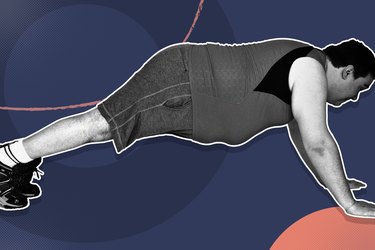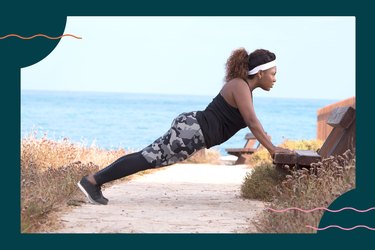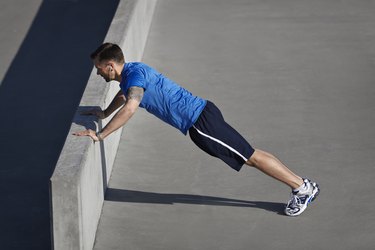
Push-ups are a go-to exercise both inside and outside of the gym to build upper-body strength without any equipment and using only your body weight.
This upper-body exercise trains both your strength and endurance. But as a compound exercise — or multi-joint exercise — the push-up is invaluable in a fitness routine, according to the American Council on Exercise (ACE).
Video of the Day
Video of the Day
By simply tweaking your hand position, such as in a wide push-up or a close grip or narrow push-up, you can easily change which muscles you target. Here are the key differences between these two set-ups, plus how they help you develop strength and endurance.
How to Do a Wide Push-Up
Wide push-up technique is similar to that of a regular push-up, according to the ACE:
- Begin in a high plank with your glutes and core engaged. Place your hands wider than shoulder-distance apart and keep your hips in line with your head and heels.
- Keeping your back in a neutral position, slowly lower down until your elbows are bent at 90 degrees (or as low as you can go with good form).
- Push away from the floor to return to the starting position.
How to Do a Narrow Push-Up
A narrow or close-grip push-up looks like a regular push-up too, except that your hands are placed closer together, according to the ACE.
- Begin in a high plank with your glutes and core engaged. Place your hands directly under your shoulders and keep your hips in line with your head and heels.
- Keeping your back in a neutral position and your elbows tucked close to your ribs, slowly lower down until your chest nearly touches the floor (or as low as you can go with good form).
- Push away from the floor to return to the starting position.
Tip
For an even more challenging push-up variation, place your hands together in a diamond position with your index fingers and thumbs touching beneath your chest.
Benefits of Wide vs. Close Push-Ups
You'll get many push-up benefits no matter which type you choose, such as burning calories and building strength, stamina and muscle growth, according to the National Academy of Sports Medicine. But there are some unique perks depending on which variation you pick.
Wide Push-Ups
The wide push-up recruits more of your chest muscles, while a regular push-up shares the load with your triceps muscles.
Just make sure to maintain the placement of your hands and positioning of your shoulders the entire time: Tell yourself "wide shoulders" throughout the movement as a cue.
Close Push-Ups
The close-grip push-up will target your triceps more than regular or wide push-ups, while still working your chest and core. This emphasis on a smaller muscle group (the triceps) makes close push-ups a more challenging movement.
You can make narrow push-ups a little easier by placing your hands on an elevated surface like a counter, wall or step for an incline push-up.
FAQ
Common Questions
How do you add push-ups to your workout?
Start with 2 sets of 5 to 6 push-ups, and rest for a minute between sets, according to the ACE. As you grow stronger, you can build up to 2 sets of 10 to 12 reps.
How many push-ups should I do a day?
There's no set number of push-ups to do daily. In fact, it's safest to include some days off from push-ups to avoid overuse injuries. Instead of doing push-ups every day, aim for a balance of push, pull and lower-body exercises throughout your week.



